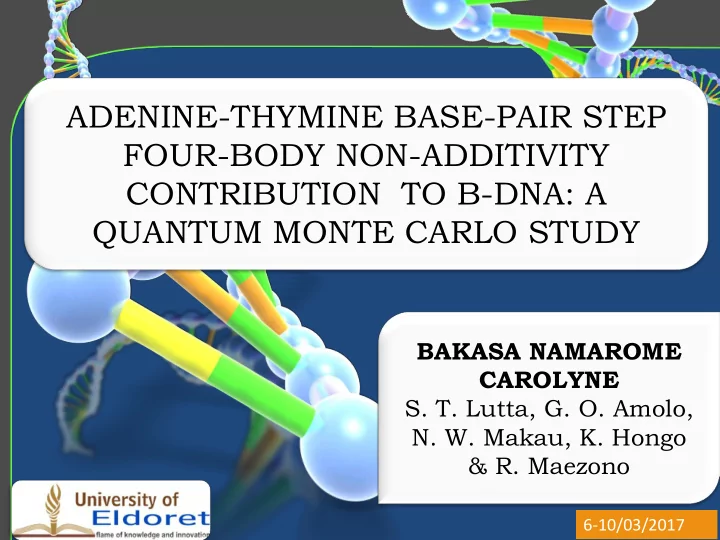

ADENINE-THYMINE BASE-PAIR STEP FOUR-BODY NON-ADDITIVITY CONTRIBUTION TO B-DNA: A QUANTUM MONTE CARLO STUDY BAKASA NAMAROME CAROLYNE S. T. Lutta, G. O. Amolo, N. W. Makau, K. Hongo & R. Maezono 6-10/03/2017
Outline 1.Inspiration 2.Introduction 3.Target system 4.Methodology 5.Results and Discussions 6.References 7.Acknowledgement
INSPIRATION Watson-Crick base-pairs Base- pairs are stacked by dispersion effects. http:// www.Structural_Biochemistry/ Nucleic_Acid/DNA/DNA_structure Hong et al., (2013) QMC can simulate correlation effects in molecules Vertical separation 3.24Å Potential Energy Graphs
INTRODUCTION Stacking is a non-covalent interaction Four-body is rarely considered in Deoxyribonucleic Acid (DNA) bases in a lot of research, yet it influences DNA dynamism Ŝponer et al., (1997). Quantum Monte Carlo Thymine Adenine (QMC) approach can simulate correlation effects stacking unlike Hatree-Fock and convectional function Density Functional Theory Four-body interaction (DFT) Hong et al., 2013.
TARGET SYSTEM Stacked Adenine-Thymine (AA:TT) geometries A:A T:T AA:TT Intra- Inter- A:T A:T Tetramer Dimers Monomers
METHODOLOGY Computation Approach Gaussian 09 CASINO code for Quantum Monte Carlo (QMC) Wavefunction : generation of single particle orbital wave-function via the LDA/SVWN with BFD-PPs can read molecular orbitals Optimization: Variance Minimization by Jastrow factor. This is done repeatedly to find the best possible solution. One with the least possible error
Variational Monte Carlo: The optimized wavefunction is used to attain the ground state total energies Diffusion Monte Carlo Configuration generation: by variance minimization ” vmc-dmc .” DMC equilibration: period of configuration the distribution chang until all walkers are distributed based on the ground state wave- function of the molecular system. Statistical accumulation: by propagation for a longer period of time allowing the collection of enough energy, E, having a sufficiently lower error bar
Stacking RESULTS AND DISCUSSION -12.04 -10.17 +9.00 - 13.10 -12.80 ± 0.6 -8.39
B3LYP cannot describe correlation effects Hongo et al., (2013). LDA reproduces the binding energy of - 10.17kcal/mol, due to not dispersion, but spurious chemical bindings (Hongo et al., 2013). M06-2X works with noncovalent effects, it treats the exchange term, though without dispersion correlation terms The B3LYP-GD3 provides for empirical dispersion of -12.04 kcal/mol and is in agreement with the CCSD(T). DMC approach is very close to the CCSD(T) value and provides for -12.80 kcal/mol and it includes correlation effects.
Four-body term +0.87 -0.08 -0.21 0.0 -0.20 -3.70 ± 0.7
QMC predicts -3.7 ±0.7kcal/mol. Provides for increased thermal stability compared to CCSD(T). LDA has a repulsive four-body term compared to other technique since it neglects the dispersion non-additivity. B3LYP, B3LYP-GD3 and M06-2X have four-body term that is agreeable with the reference CCSD(T) Non-additivity contributes to the total DNA stacking interactions and influences DNA dynamism.
c) Binding Energies tetramer and dimers Basis Set Superposition Error, BSSE – eliminated by counterpoise, CP method -it approximately estimates the BSSE size. QMC values are approximately half of the DFT simulations QMC approach includes the correlation effects thus improved the description of binding energies for the targeted systems
ii) Dimers A:A and T:T AA’:TT’ most stable it experiences more -13.0 ± 0.4 interactions hence stronger bindings. H-bonding Stacking intra- & Inter-strand stacking T//T less stable than A//A. The methyl group repulsion H-bonding A//A binding is more -2.3 ± 0.3 stable - 4.3 ± 0.3
Conclusion QMC can provide for stacking interaction -12.80kcal/mol which agrees with the reference CCSD(T) -13.10kcal/mol QMC value of -3.7 ±0.7kcal/mol AA:TT four-body term predicts increased thermal stability. QMC also confirms that AA:TT binding energy is the most stable DNA form . Recommendation Inclusion of the sugar-phosphate backbone in the study of stacking and four-body term.
References • Dahm, R. (2008). Discovering DNA: Friedrich Miescher and the early years of nucleic acid research. Human genetics, 122 (6), 565- 581. • Hongo, K., Cuong, N. T., and Maezono, R. (2013). The importance of electron correlation on stacking interaction of adenine-thymine base-pair step in B-DNA: A quantum Monte Carlo study. Journal of chemical theory and computation, 9(2), 1081-1086. • Needs, R. J., Rajagopal, G., Towler, M. D., Kent, P. R. C., and Williamson, A. J. (2000). CASINO version 1.0 Users Manual. University of Cambridge, Cambridge . • Olson, W. K., Bansal, M., Burley, S. K., Dickerson, R. E., Gerstein, M., Harvey, S. C., ... and Berman, H. M. (2001). A standard reference frame for the description of nucleic acid base-pair geometry . Journal of molecular biology , 313(1), 229-237 .
ACKNOWLEDGEMENT University Of Eldoret, Kenya Japan Advance Institute of Science and Technology, (JAIST), Japan Gaussian 09 and CASINO Code developers International Centre for Theoretical Physics (ICTP), Italy
Recommend
More recommend